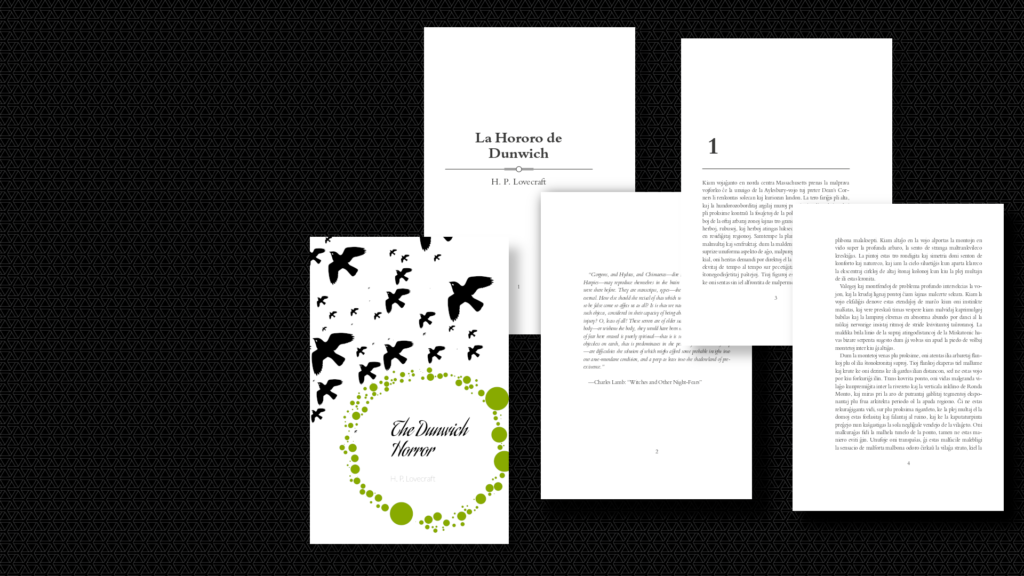Stranga Amuzajxo
Combining my love of learning languages with my interest in the art of book making, I’ve translated a favorite story into Esperanto.
So one of my strange hobbies is to translate some of my favorite stories into other languages, just for kicks. And for some reason, I decided that when I translate stories by H. P. Lovecraft, the language to use must be Esperanto. If you’re not familiar with Esperanto, it is a language that was constructed in 1887 by L. L. Zamenhof, an opthalmologist from Poland. It is now one of the most widely used constructed languages in the world. You can even take lessons in Esperanto on Duolingo, one of my favorite apps.

Recently, I finished translating one of my favorite Lovecraft stories, The Dunwich Horror. The following is an example of the first paragraph of the story:
“Kiam vojaĝanto en norda centra Massachusetts prenas la malprava vojforko ĉe la unuigo de la Aylesbury-vojo tuj preter Dean’s Corners li renkontas solecan kaj kuriozan landon. La tero fariĝis pli alta, kaj la hundorozo-borditaj argilaj muroj premis sin pli proksime kaj pli proksime kontraŭ la fosaĵetoj de la polva kurbiganta vojo. La arboj de la oftaj arbaraj zonoj ŝajnas tro grandaj, kaj la sovaĝaj malbonherboj, rubusoj, kaj herboj atingas lukseco kiu estas ne ofte trovita en residiĝitaj regionoj. Samtempe la plantitaj agroj aspektas unike malmultaj kaj senfruktaj; dum la maldense dispersitaj domoj portas suprize unuforma aspekto de aĝo, malpuregeco, kaj kaputeco. Sen scii kial, oni hezitas demandi por direktoj el la malbelformaj, solaj figuroj ekvitaj de tempo al tempo sur pecetiĝitaj sojloj aŭ sur la deklivaj ŝtonego-disĵetitaj paŝtejoj. Tiuj figuroj estas tiaj mutaj kaj kaŝemaj ke oni sentas sin iel alfrontita de malpermesitaj aferoj, kun kiu estus plibona malaksepti. Kiam altaĵo en la vojo alportas la montojn en vido super la profunda arbaro, la sento de stranga maltrankvileco kreskiĝas. La pintoj estas tro rondigita kaj simetria doni senton de konforto kaj natureco, kaj iam la cielo siluetiĝis kun aparta klareco la ekscentraj cirkloj de altaj ŝtonaj kolonoj kun kiu la plej multajn de ili estas kronita. ”
Now, I’m still a relative novice at Esperanto, although translating this story has helped immensely. I will probably at some point go back through it and make some changes, as I’ve learned a lot as I went along. One of my biggest problems was figuring out what to use for “whippoorwil” as I could not find a translation for that in any of the Esperanto dictionaries I could locate. I ended up using “kaprimulgo,” which is the word for “nightingale,” a related species. I thought of coining “wiporwilo,” but I ended up not doing that. I sent out a call to the Esperanto community on Twitter, but I didn’t get any good responses.
When I translate a story, I tend to use Sigil, so that the completed story can automatically be used as an e-book. But one of the other things I’m hoping to do one day is to try my hand at bookbinding, so I’ve been preparing La Hororo de Dunwich in a layout to be printed and bound. I was trying to explain why this is so satisfying, but there’s something about finding a good font and typeface that supports all the Esperanto characters (in this case I’m using Borgia Pro) and adjusting the tracking and hyphenation to get nice evenly spaced justified text. Geek moment while doing this: I found a hyphenation dictionary that was able to install into Scribus, so that it would take care of the hyphenation for me, and I wanted to cheer.
So, my first step will be to complete the typesetting of the book. The image for this blog are examples of the cover design and layout. The next step will be working on the actual printing of the book by getting the page ordering correct for printing and printing in the right paper.